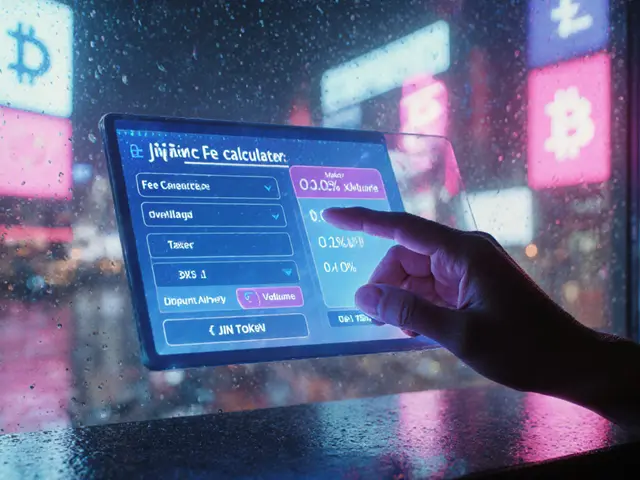Ailey (ALE) Token Tracker
Current Market Overview
Current Price
24h Change
Market Cap
Circulating Supply
Key Features
- Blockchain: Ethereum (ERC-20) & Binance Smart Chain (BEP-20)
- Use Cases: Staking, Yield Farming, NFT-enabled DeFi
- Max Supply: 1 Billion ALE
- Trading Volume (24h): $0.4M - $2.6M
Comparison with Major DeFi Tokens
| Token | Primary Chain | Max Supply | Market Cap (2025) | 24h Volume |
|---|---|---|---|---|
| ALE | Ethereum & BSC | 1B | $205M | $0.4M-$2.6M |
| UNI | Ethereum | 1B | $7.3B | $180M |
| SUSHI | Ethereum | 250M | $1.2B | $35M |
Ailey (ALE) shows strong performance with a 162-171% increase in 2025. Its dual-chain architecture offers flexibility between Ethereum security and BSC low fees.
To begin investing in ALE:
- Set up a compatible wallet (MetaMask or Trust Wallet)
- Acquire ETH or BNB on a centralized exchange
- Swap for ALE on PancakeSwap (BSC) or Uniswap (Ethereum)
- Store securely and consider staking for passive income
- Liquidity slippage on smaller trades
- Ethereum gas fees during congestion
- Competition from major DeFi projects
- Potential regulatory changes
About Ailey (ALE)
Ailey (ALE) is a mid-cap cryptocurrency launched in August 2023. It operates on both Ethereum (ERC-20) and Binance Smart Chain (BEP-20), offering users flexibility in transaction costs and security. The token serves three core functions: facilitating payments, enabling governance participation, and rewarding stakers and liquidity providers.
ALEY's ecosystem includes staking pools, yield farms, and an integrated NFT module allowing fractional ownership of real-world assets. With a max supply of 1 billion tokens and approximately 393 million currently circulating, ALE has shown significant growth since its launch, reaching an all-time high of $0.587 in May 2025.
Ever wonder why a mid‑cap token like Ailey keeps popping up in DeFi talks? You’re probably curious about its real purpose, how it fits into the broader crypto landscape, and whether it’s worth a look in 2025. This guide pulls together the facts, numbers, and practical steps so you can decide fast.
Quick Take
- Ailey (ALE) runs on both Ethereum (ERC‑20) and Binance Smart Chain (BEP‑20).
- Market cap sits around $205million, ranking #224 by value.
- Price has stabilized between $0.51‑$0.58 after a 2025 rally.
- Key services include staking, yield farming, and NFT‑enabled DeFi.
- Getting started needs a compatible wallet (MetaMask or Trust Wallet) and a DEX that lists ALE.
What Is Ailey (ALE) Token?
Ailey (ALE) is a blockchain‑based cryptocurrency that powers Project Ailey, a decentralized finance ecosystem aimed at financial inclusion. Launched in August2023, ALE’s smart‑contract address is 0x9dCE13E71B11eb5Df66ca269bD657696587Fd4E2. The token serves three core roles: moving value within the Aileyverse, letting holders vote on protocol upgrades, and distributing rewards from staking or yield farms.
Dual‑Chain Architecture: ERC‑20 Meets BEP‑20
Project Ailey chose a multi‑chain strategy to blend Ethereum’s security with Binance Smart Chain’s low fees. On Ethereum, ALE follows the ERC‑20 standard for fungible tokens on the Ethereum network. On BSC, it adopts the BEP‑20 token standard that mirrors ERC‑20 but runs on the Binance Smart Chain. This duality lets users pick the chain that best fits their transaction size and urgency.
Core Use Cases
- Payments: ALE can be used for peer‑to‑peer transfers or to pay for services within the Ailey ecosystem.
- Governance: Token holders vote on proposals via the on‑chain DAO, influencing fee structures, new product launches, and partnership decisions.
- Rewards: Stakers earn a share of protocol fees, while liquidity providers collect a portion of trading fees from the built‑in DEX.
DeFi Services: Staking, Yield Farming, and NFTs
The Ailey platform bundles traditional DeFi tools with NFT functionality. Users can lock ALE in staking pools to earn a fixed APR, or join yield farms that pair ALE with other liquidity tokens for variable returns. The NFT module lets creators mint tokens that represent fractional ownership of real‑world assets, and those NFTs can be used as collateral in ALE‑backed loans.

Market Performance & Key Metrics
As of October2025, ALE trades around $0.55 on most exchanges, a solid 162‑171% gain over its first year. The token’s max supply is capped at 1billion ALE tokens, with about 393million circulating. The 24‑hour trading volume ranges from $0.39million to $2.65million, indicating moderate liquidity. A recent analyst note from Bitrue projected a 150‑200% rise by year‑end; the token actually hit an all‑time high of $0.587 on May252025, a 439% jump from its low of $0.1088 at the end of 2024.
How ALE Stacks Up Against Similar DeFi Tokens
| Token | Primary Chain | Max Supply | Market Cap (2025) | 24h Volume |
|---|---|---|---|---|
| ALE | Ethereum & BSC | 1B | $205M | $0.4‑$2.6M |
| UNI | Ethereum | 1B | $7.3B | $180M |
| SUSHI | Ethereum | 250M | $1.2B | $35M |
Compared to UNI and SUSHI, ALE offers a lower barrier to entry and a built‑in NFT layer, but it also suffers from thinner liquidity and fewer exchange listings.
How to Get Started: Wallets, Exchanges, and First Steps
To interact with ALE you’ll need a wallet that supports both ERC‑20 and BEP‑20 tokens. MetaMask is the go‑to browser extension for Ethereum‑compatible assets works for the Ethereum side, while Trust Wallet offers native BSC support and easy QR‑code swaps handles the Binance Smart Chain side. Once your wallet is funded, you can acquire ALE on decentralized exchanges like PancakeSwap (BSC) or Uniswap (Ethereum) by swapping ETH/BNB for ALE. Remember to approve the token contract when prompted; this step enables the DEX to move ALE on your behalf.
Risks & Considerations
- Liquidity slippage: With daily volume under $3M, large orders can move the price noticeably.
- Chain congestion: Ethereum gas spikes still affect ALE transactions, though BSC offers a cheaper fallback.
- Competitive pressure: Established DeFi platforms enjoy deeper pools and broader brand trust.
- Regulatory outlook: Emerging compliance rules in the U.S. and EU could limit certain DeFi features.
Balancing these factors against ALE’s inclusion‑first vision will help you decide the right exposure level.
Community, Development, and Future Outlook
The Ailey team has kept a steady release cadence through 2025, delivering upgrades that improve cross‑chain bridges and enhance NFT collateral logic. Community sentiment on platforms like Reddit and CoinGecko is generally positive, praising the token’s price stability and transparent governance updates. However, the community size remains modest, and the project still seeks listings on larger centralized exchanges to broaden its reach.
Looking ahead, the dual‑chain model positions ALE to capture users who want Ethereum‑level security without paying prohibitive fees. If the team can lock in new partners-especially in the NFT and real‑world asset space-ALE could differentiate itself further and potentially climb into the top‑150 DeFi tokens.
Frequently Asked Questions
What blockchain does ALE run on?
ALE exists as both an ERC‑20 token on Ethereum and a BEP‑20 token on Binance Smart Chain, giving users a choice between security and low fees.
How can I earn rewards with ALE?
Staking ALE in the protocol’s reward pools yields a fixed APR, while providing liquidity to ALE‑paired farms generates variable returns based on trading fees.
Is ALE safe to store on MetaMask?
Yes, as long as you verify the contract address (0x9dCE13E71B11eb5Df66ca269bD657696587Fd4E2) and keep your private key secure.
What is the total supply of ALE?
The maximum supply is 1billion ALE tokens, with roughly 393million already circulating.
Where can I trade ALE today?
ALE is listed on decentralized exchanges such as Uniswap (Ethereum) and PancakeSwap (BSC). Some centralized exchanges have added limited pairings, but DEXs remain the primary venues.





Comments
22 Comments
Cody Harrington
I’ve been keeping an eye on ALE’s dual‑chain rollout and it’s pretty impressive how the team balances Ethereum security with BSC fee savings. The recent price swing shows decent upside, especially for those willing to hop chains. If you’re into staking, the APRs look competitive compared to UNI’s pools. Overall, ALE feels like a solid midsize player in the DeFi space.
Chris Hayes
While ALE’s numbers look shiny, the thin liquidity is a red flag. You’ll see slippage on even modest trades, and the token’s market cap is tiny next to the heavyweights. The dual‑chain gimmick helps fees, but it also splits community focus. Proceed with caution and size your position accordingly.
victor white
One must ponder whether ALE’s NFT‑enabled DeFi is a genuine innovation or merely a veneer of hype. The protocol’s architecture, while technically sound, appears designed to ride the current wave of tokenized assets. In a market saturated with ERC‑20 clones, the question remains: does ALE truly differentiate itself beyond superficial cross‑chain bragging?
mark gray
From a practical standpoint, ALE’s staking guides are clear and the wallet setup isn’t too tricky. Just make sure you add the right contract address to avoid phishing traps. The token’s price stability over the past few weeks is encouraging for newcomers.
Emily Pelton
Listen up, folks! If you want real gains, you need to jump on ALE’s staking pools right now-don’t wait for the “official” hype train. The rewards are already outpacing many of the big‑name tokens, and the NFT integration adds a unique edge. Get your MetaMask ready, approve the contract, and lock those tokens before the next surge!
sandi khardani
Let me break down why ALE is a fascinating case study in the current DeFi landscape. First, the token operates simultaneously on Ethereum and Binance Smart Chain, giving users the flexibility to choose between security and low transaction fees. Second, the launch of its NFT‑enabled module opens a pathway for fractional ownership of real‑world assets, which could attract a broader investor base beyond typical crypto enthusiasts. Third, the staking rewards structure appears sustainable, distributing a portion of protocol fees back to participants, which aligns incentives across the ecosystem. Fourth, the governance mechanism allows token holders to vote on critical upgrades, fostering a sense of community ownership. Fifth, the circulating supply of roughly 393 million tokens out of a capped one‑billion provides ample room for growth without immediate inflationary pressure. Sixth, despite its modest market cap of $205 million, ALE posted a remarkable 162‑171 % price increase in 2025, indicating strong market momentum. Seventh, liquidity, while still thin compared to giants like UNI, has been improving, with daily volumes ranging from $0.4 M to $2.6 M, suggesting increasing trader interest. Eighth, the dual‑chain architecture mitigates the risk of network congestion; when Ethereum gas spikes, users can shift to BSC for cheaper transactions. Ninth, the project’s roadmap includes upcoming partnerships in the NFT and real‑estate sectors, which could further enhance token utility. Tenth, the development team has demonstrated consistent transparency with regular updates, a factor often overlooked but crucial for long‑term confidence. Eleventh, community sentiment on platforms like Reddit and CoinGecko remains generally positive, highlighting user satisfaction with recent upgrades. Twelfth, the token’s price stability between $0.51 and $0.58 after the rally provides a more predictable entry point for investors. Thirteenth, the risk factors-such as regulatory scrutiny and competition from established DeFi protocols-are openly acknowledged in their whitepaper, reflecting a mature approach to risk management. Fourteenth, the token’s smart‑contract address is verified, reducing the chance of malicious code. Finally, while ALE is not without challenges, its blend of dual‑chain flexibility, NFT integration, and community‑driven governance makes it a noteworthy contender worth monitoring closely.
Donald Barrett
Agree with the earlier points-still, the price jump feels speculative. Watch the volume spikes; a sudden dip could wipe out gains.
Christina Norberto
From a formal perspective, the protocol’s documentation adheres to industry standards, but the lack of third‑party audit reports remains a concern. Investors should seek verifiable security assessments before allocating significant capital.
Fiona Chow
Honestly, ALE’s hype is almost as big as its actual utility. The cross‑chain feature is cool, but without deep liquidity, it’s just another token riding the wave.
Rebecca Stowe
Great potential, keep watching.
Aditya Raj Gontia
Nice overview, though the jargon could be trimmed for newcomers.
Kailey Shelton
Sounds promising, but I’m not sold yet.
Angela Yeager
For anyone unsure about the contract address, double‑check the official site or the verified Etherscan listing before adding the token to your wallet. A simple mistake there can lead to loss of funds.
vipin kumar
That’s solid advice; I’ve seen too many cases where users paste the wrong address and end up with a scam token.
Lara Cocchetti
While ALE markets itself as inclusive, the token’s scarcity could actually limit broader adoption. A larger circulating supply might foster more widespread use.
Mark Briggs
Yeah, but a thin supply also means each holder has more influence over governance decisions.
mannu kumar rajpoot
Considering regulatory trends, cross‑chain tokens like ALE could face additional scrutiny, especially with NFT collateralization.
Tilly Fluf
That’s a fair point; however, the team’s proactive compliance updates suggest they’re ready to adapt.
Darren R.
Let’s be honest-crypto projects thrive on hype cycles. ALE’s current surge might be more about FOMO than fundamentals, but if they deliver on roadmap promises, the upside could be significant.
Hardik Kanzariya
I’ve been following ALE’s development updates; the upcoming bridge enhancements could improve cross‑chain speed, which is a tangible improvement.
Shanthan Jogavajjala
Bridge upgrades sound good, yet the underlying tokenomics still need more clarity regarding long‑term token burn mechanisms.
Karl Livingston
Agreed, a clear burn schedule would help sustain price appreciation and reassure investors about supply dynamics.
Write a comment